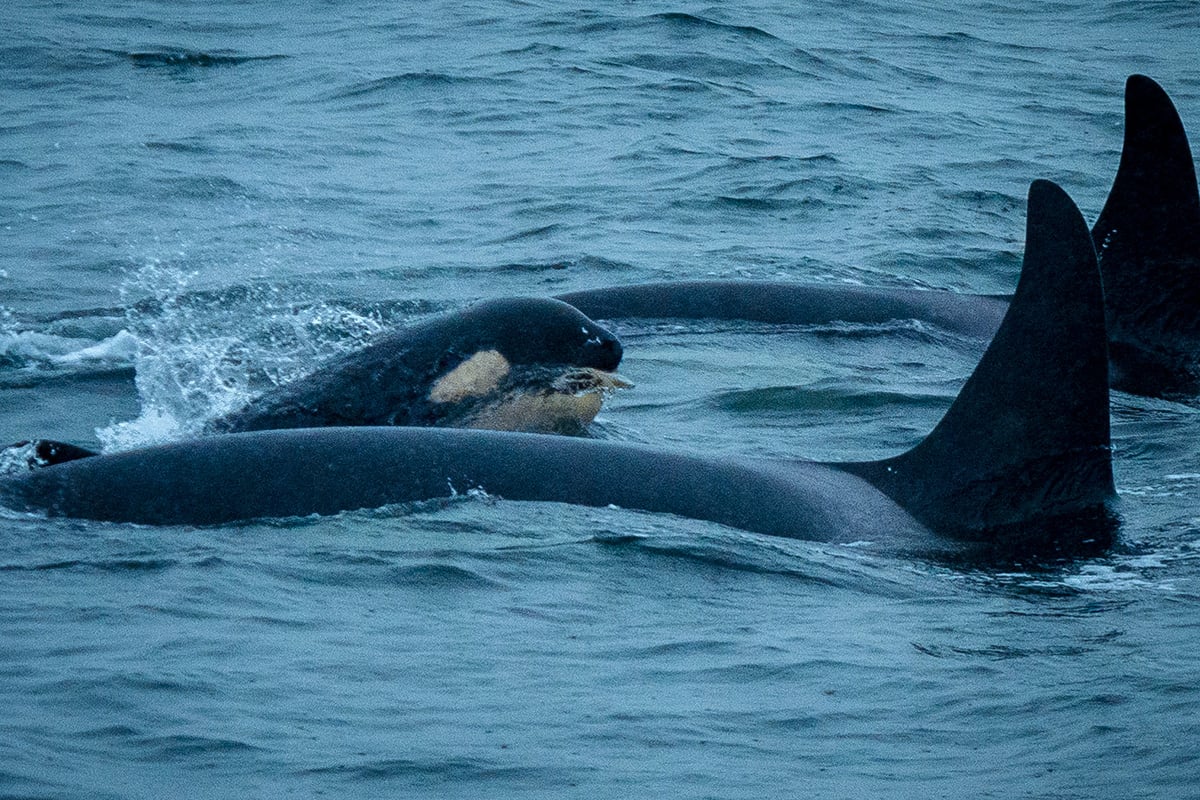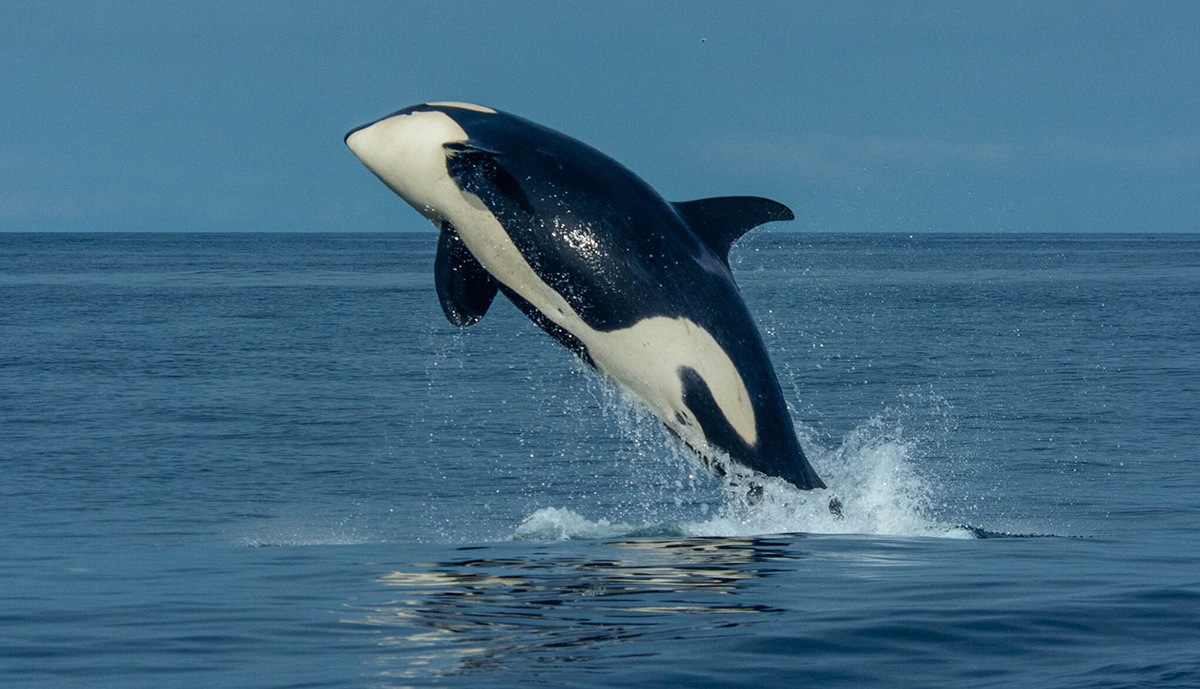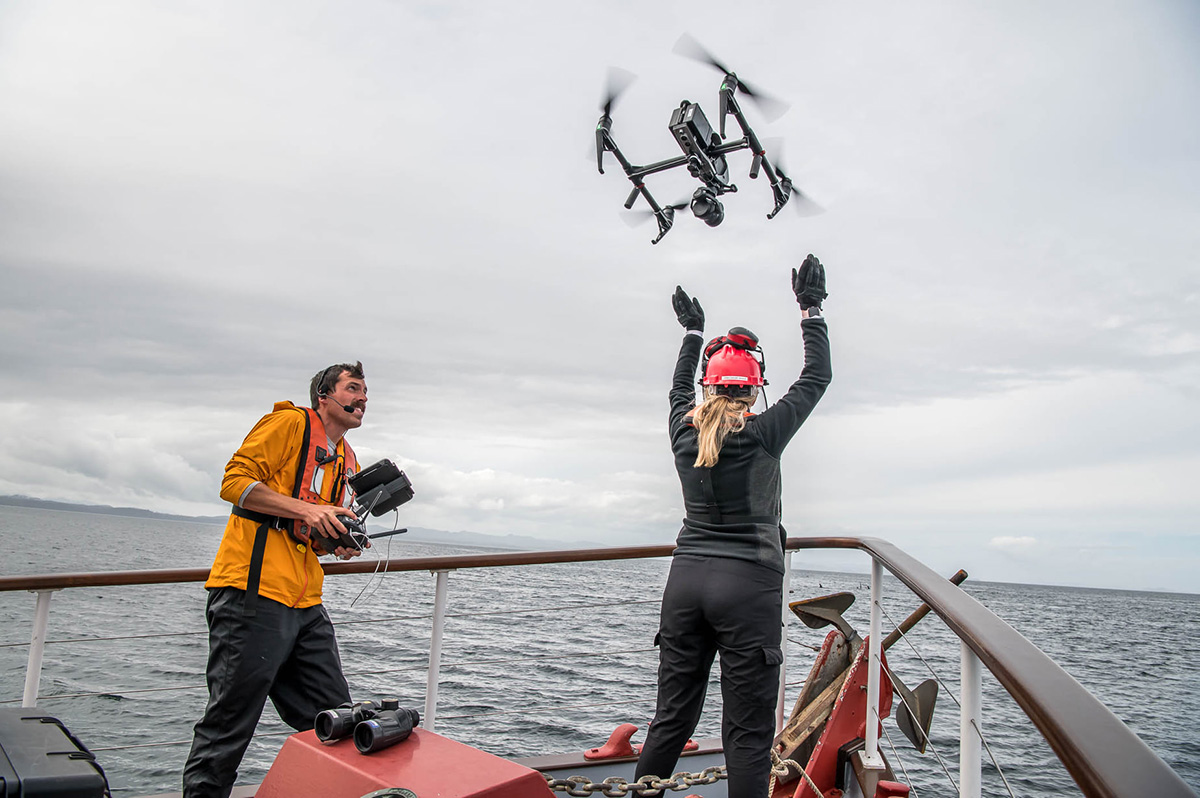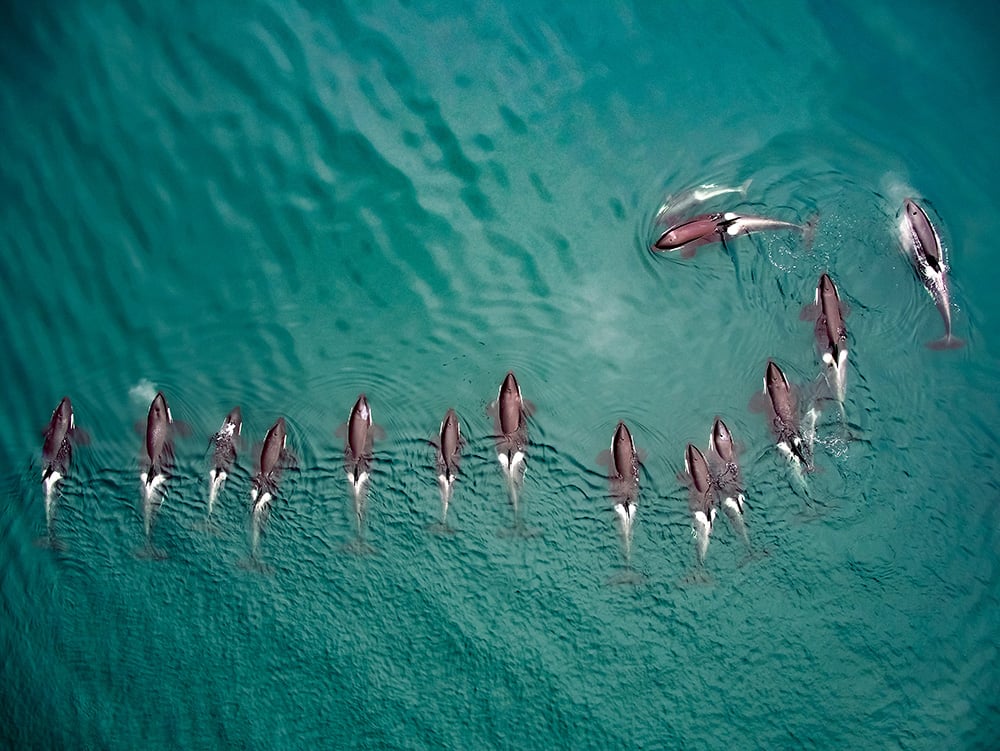Late last summer, a team of scientists from the University of British Columbia tracked southern and northern resident killer whales off the B.C. coast using cutting-edge technology that opened a new window into the lives of these charismatic creatures.
The array of high-tech tools included aerial drones, electronic fish finders and data loggers equipped with satellite telemetry, a gyroscope, hydrophone and an underwater camera. Attached to the killer whales with suction cups, these devices allowed the scientists to record what the whales see and hear, as well as their movements in the water, and their diving and hunting behaviour.
The video clips, collected from above and below the water, samples of which can be viewed here were arresting. "Some of the images took our breath away," says team leader Andrew Trites, a professor at the Institute for the Oceans and Fisheries Department of Zoology and the director of the Marine Mammal Research Unit at UBC. “It was amazing to watch the whales rolling through the water and moving in three-dimensions.”
Take a ride, for example, as if on the back of an orca, swimming among dolphin companions:
Trites was especially struck by the orcas’ physical interplay. “I don't think that I'd ever fully appreciated just how tactile the whales are. It's probably one way that they use to maintain this very strong family bond they have. They are very social creatures. They survive not by being alone, but by being together.”
In one poignant video, a northern resident baby can be seen being nuzzled by her mother, before she slides along her mother's body and playfully slaps mom on the head with her tail. In another image, a new calf was observed carrying a salmon in her mouth like a rag doll for two days, even though she was only three months old and still feeding entirely on her mother's milk. Is this a form of teething, or is the baby simply learning to copy adults? Scientists can’t be sure.

But beyond collecting stunning visuals, the central aim of the project is to investigate the feeding habits and prey availability of the northern and southern residents, both of whom forage for Chinook salmon along the B.C. coast. During summer and fall, the two groups are in close proximity with the northern residents patrolling Johnstone Strait on the east side of Vancouver Island, while the southern residents circulate just to the south in the Salish Sea.
Although essentially the same type of animals, they have different dialects and rarely interact and never interbreed. They are also very different in health. The endangered southern residents are thinner on average than the northern residents and far fewer in numbers, having declined from a high of 98 in 1995 to just 75 today, while the northern residents boast a population of more than 300.
The UBC researchers hope their data will furnish new clues as to why the northern residents are thriving while the southern residents are drifting toward extinction. “By observing both populations of killer whales we’re able to compare the foraging conditions and hunting behaviours of the two groups and see whether it is more difficult for southern residents to capture prey,” explains Sarah Fortune, a postdoctoral fellow in marine ecology at MMRU, and head of the tracking aspect of the project, which is part of a multi-year investigation supported by Fisheries and Oceans Canada, the National Sciences and Engineering Research Council of Canada, the Pacific Salmon Foundation and the Hakai Institute.
The plight of the southern residents received intense global coverage in 2018 when a mother named Tahlequah carried the corpse of her dead calf for 17 days in what some journalists described as “a tour of grief.” Scientists were less willing to ascribe motive. As Peter Ross, a killer whale expert and vice-president of research of the conservation group Ocean Wise, noted, “This is unusual behaviour. We haven’t seen it before. What it means — who knows?”

Because of their small population and because they live near large urban centres, the southern residents are among the most studied mammals on the planet with each member individually documented. Even so, there is still much that we don’t know about them. “They’re difficult to study because they spend 95 percent of their lives underwater. For example, we don’t know to what extent they feed at night,” notes John Ford, one of the pioneer killer whale researchers.
The root cause of the southern residents’ decline is still debated. Most observers cite three factors: reduced food supply, noise and physical interference from commercial and recreational vessels, and an accumulation of industrial chemicals in their blubber.
Both groups eat only fish, preferably Chinook, but the habitat of the northern residents has cleaner, quieter water and provides a more diverse array of salmon runs from which to choose, including Fraser River Chinook, which they can pick off on the salmons’ return to the spawning grounds before the southern residents get their shot.
The orcas prefer Chinook because they are the largest and richest type of salmon, but these coveted fish are in decline, their numbers having fallen dramatically in the last century due to fishing, farming, the construction of dams, industrial activity and the destruction of estuaries. Even so, Trites notes that mathematical models indicate that the southern residents should be able to obtain an adequate supply of Chinook in the Salish Sea, which suggests that other factors may be involved.

In a recent paper, University of Washington biologist Samuel Wasser, reported that from 2008 to 2014, nearly 70 percent of southern resident killer whale pregnancies failed, either in miscarriage or with the calves dying shortly after birth. Wasser believes these failures are occurring because reduced food intake is triggering the pollutants in their bodies. When the whales don’t get enough to eat, they start to burn their fat reserves, which releases the stored toxins into their bloodstreams. This hurts the health of the developing calf, and the effect is particularly pronounced late in the pregnancy when the fetus is growing rapidly.
It’s also possible that ambient noise is impairing these animals’ ability to hunt. Marla Holt, a wildlife biologist with the U.S. National Oceanic and Atmospheric Administration, says that data collected on hydrophone tags has revealed that less foraging is done by the whales when vessels are closer than 350 metres. The presence of ship traffic seems to especially impact the females. Holt says that the noise generated by passing vessels has a masking effect, “reducing the whales ability to identify sounds of interest.”
Loud sounds could certainly disrupt the orcas’ biological sonar. When hunting, a killer whale emits a series of clicks that spread through the water like a flashlight beam of sound. If the sound waves hit an object, echoes bounce back to the whale. Echolocation allows orcas to detect fish at distances of up to 150 metres, much farther than they could see in the dark water and it allows them to co-ordinate their hunting efforts in the absence of light or other recognizable features beneath the waves.
The UBC team’s underwater cameras highlighted the murkiness of the world the killer whales inhabit and crystalized the importance of their use of echolocation to navigate and hunt. Hydrophone recorders even allowed the researchers to eavesdrop as the orcas chased their prey.
“They are in the deep, dark water, it sounds like a submarine — ping, ping, ping,” says Trites, describing the echolocation clicks. “Faster and faster, it turns into a buzz and you know the kill moment is coming. Suddenly you hear the crunch as they bite down. And then, silence.”
The UBC crew employed two vessels in their tracking efforts, the Gikumi, an 18-metre-long mothership, and the Steller Quest, a six-metre-long aluminum-hulled boat used when attaching data loggers to the orcas. This task, which requires strength, skill and teamwork, was handled by biologist Mike deRoos and skipper Chris Hall, a veteran commercial marine operator.
DeRoos stood near the front of the skiff holding an eight-metre-long, carbon-fibre pole with the tag attached at the top, while Hall carefully piloted the vessel alongside one of the 5,000-kg leviathans. DeRoos would wait, peering into the water through polarized sunglasses until he saw an orca rising from below, and then as it broke the surface, attempt to slap the suction cup on its back near the dorsal fin. “It’s quite challenging. They typically only surface for about two seconds, and their skin is slippery, says deRoos, “You need to get the timing just right because if they see the pole hovering above then they won’t come up.”
Once attached, a data logger will transmit for five, seven or 20 hours, depending on its programming. At the end of that time, the device releases, floats to the surface and emits a radio signal to help the crew retrieve it. The storehouse of information contained on these instruments is revelatory. “Some of the things we recorded will refine current understanding of how killer whales live together, hunt, share food and communicate with one another,” says Fortune.
The data accumulated on the month-long expedition, which saw the research team travel more than 2,500 km, is so large that the scientists are still sorting through the material and working toward conclusions. One critical question they hope to answer is whether the suspected food shortage that southern resident killer whales are experiencing is occurring in the Salish Sea during summer and fall, or if it’s happening elsewhere in their range during winter and spring.
Ironically, the cold sterility of technology, so often linked with the notion of asserting dominance over nature, is now opening a gateway for biologists to study animals in a more intimate and revealing manner. In this brave new world, the killer whales themselves function as oceanographers, revealing the watery realm they inhabit with minimal disruption to their lives.
Gaining a more complete picture of what is transpiring underwater with the orcas was not only a scientific breakthrough, but an emotionally rewarding experience for the UBC researchers. “This technology has opened our eyes to things we were blind to before,” says Trites. “It’s incredibly exciting. This is what gets us up each day, the chance that we might discover something new.” ![]()
Read more: Science + Tech, Environment
















Tyee Commenting Guidelines
Comments that violate guidelines risk being deleted, and violations may result in a temporary or permanent user ban. Maintain the spirit of good conversation to stay in the discussion.
*Please note The Tyee is not a forum for spreading misinformation about COVID-19, denying its existence or minimizing its risk to public health.
Do:
Do not: